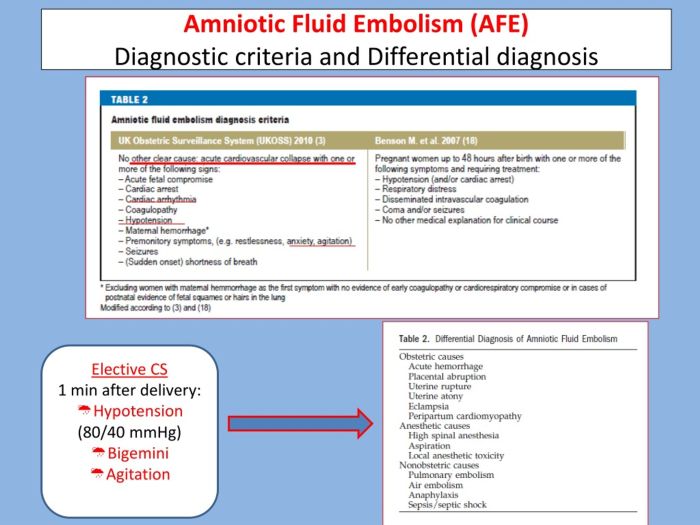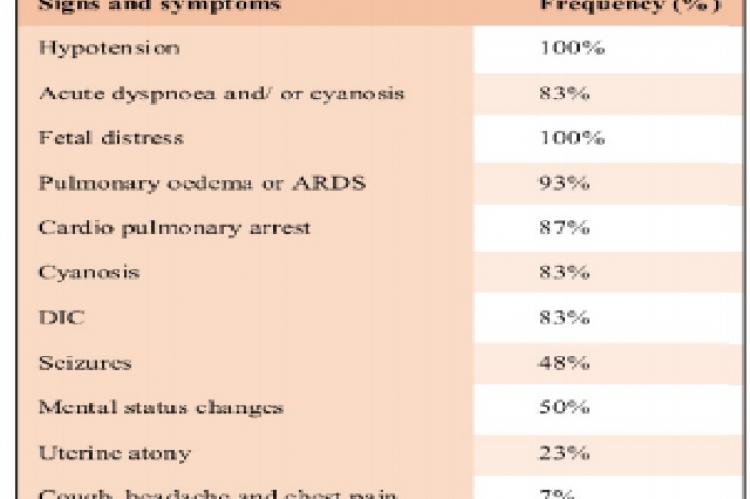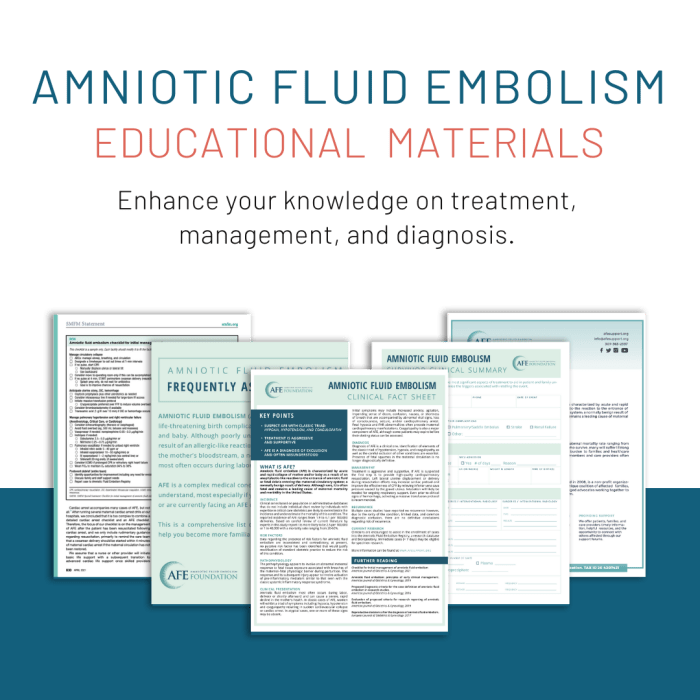Aok for amniotic fluid embolism – Amniotic fluid embolism (AFE) is a rare but life-threatening complication of pregnancy that occurs when amniotic fluid enters the maternal bloodstream. This can trigger a severe allergic reaction, leading to cardiovascular collapse and respiratory distress. In this article, we delve into the causes, diagnosis, and management of AFE, providing a comprehensive guide for healthcare professionals and individuals seeking information about this condition.
AFE is a medical emergency that requires prompt recognition and treatment. Understanding the risk factors, clinical presentation, and treatment strategies is crucial for improving patient outcomes. This article aims to provide a thorough overview of AFE, empowering readers with the knowledge they need to navigate this complex condition.
Definition of Amniotic Fluid Embolism (AFE)

Amniotic fluid embolism (AFE) is a rare but life-threatening condition that occurs when amniotic fluid and fetal matter enter the maternal bloodstream during labor or delivery.
AFE triggers a severe allergic reaction, leading to inflammation and widespread organ dysfunction. The exact cause of AFE is unknown, but it is thought to be related to the release of inflammatory mediators into the maternal circulation.
Pathophysiology
The pathophysiology of AFE involves several key steps:
- Entry of amniotic fluid into the maternal circulation
- Activation of the complement system, a part of the immune system
- Release of inflammatory mediators, such as histamine and cytokines
- Widespread inflammation and organ dysfunction, particularly affecting the lungs, heart, and brain
Risk Factors for AFE

Amniotic fluid embolism (AFE) is a rare but life-threatening obstetric emergency. While the exact cause of AFE is unknown, several risk factors have been identified that can increase a woman’s chances of developing this condition.
Maternal Age and Parity
- Advanced maternal age (over 35 years) is associated with an increased risk of AFE.
- Women who are pregnant for the first time (nulliparous) are also at higher risk.
Underlying Medical Conditions
- Certain medical conditions, such as pre-eclampsia, gestational hypertension, and diabetes, can increase the risk of AFE.
- Women with a history of bleeding disorders or clotting problems are also more likely to develop AFE.
Labor Induction and Augmentation
- Labor induction and augmentation, which involve using medications or procedures to speed up labor, can increase the risk of AFE.
- This is because these interventions can cause uterine contractions that are too strong or frequent, leading to increased pressure in the uterus and potentially allowing amniotic fluid to enter the bloodstream.
Diagnosis of AFE

Diagnosing AFE can be challenging due to its rarity and the similarity of its symptoms to those of other conditions. However, there are specific diagnostic criteria that can help healthcare providers make a more accurate diagnosis.
Clinical Signs and Symptoms
The clinical signs and symptoms of AFE can vary depending on the severity of the embolism. Some of the most common symptoms include:
- Sudden onset of shortness of breath
- Chest pain or tightness
- Coughing up pink or frothy sputum
- Rapid heart rate
- Low blood pressure
- Confusion or loss of consciousness
Laboratory Tests
Laboratory tests can help to confirm the diagnosis of AFE by detecting the presence of amniotic fluid in the bloodstream. These tests may include:
- Amniotic fluid embolism syndrome (AFES) test:This test detects the presence of a specific protein called alpha-fetoprotein (AFP) in the mother’s blood. AFP is normally found in the amniotic fluid, so its presence in the bloodstream indicates that amniotic fluid has entered the circulation.
- Coagulation studies:These tests measure the blood’s ability to clot. AFE can cause a decrease in the blood’s clotting ability, which can lead to excessive bleeding.
Imaging Studies
Imaging studies can also be helpful in diagnosing AFE. These studies may include:
- Chest X-ray:This test can show signs of fluid in the lungs, which can be a sign of AFE.
- Echocardiogram:This test uses sound waves to create images of the heart. An echocardiogram can show signs of heart failure, which can be a complication of AFE.
- Magnetic resonance imaging (MRI):This test uses magnetic fields and radio waves to create detailed images of the brain. An MRI can show signs of brain damage, which can be a complication of AFE.
Autopsy Findings, Aok for amniotic fluid embolism
In some cases, an autopsy may be necessary to confirm the diagnosis of AFE. An autopsy can reveal the presence of amniotic fluid in the lungs, heart, or brain.
Treatment of AFE

Treatment for AFE is focused on stabilizing the patient and providing supportive care. This includes aggressive resuscitation, supportive measures, and specific therapies to address the underlying cause and complications of AFE.
Principles of Management
The principles of management for AFE involve a multidisciplinary approach, including critical care, obstetrics, and anesthesiology. The goal is to provide immediate resuscitation, maintain organ function, and prevent further complications.
Resuscitation measures include:
- Aggressive fluid resuscitation with crystalloids and colloids
- Vasopressor support to maintain blood pressure
- Mechanical ventilation to support oxygenation and ventilation
Supportive care includes:
- Control of hemorrhage and coagulopathy
- Management of seizures and cerebral edema
- Prevention and treatment of infection
Specific therapies may include:
- Thrombolysis or embolectomy to remove the amniotic fluid emboli
- Corticosteroids to reduce inflammation and edema
- Antibiotics to prevent or treat infection
Vasopressors, Fluids, and Mechanical Ventilation
Vasopressors are used to maintain blood pressure and organ perfusion. Commonly used vasopressors include epinephrine, norepinephrine, and vasopressin.
Aggressive fluid resuscitation is essential to restore intravascular volume and prevent hypotension. Crystalloids and colloids are used to expand the intravascular space and improve tissue perfusion.
Mechanical ventilation is necessary to support oxygenation and ventilation. Positive end-expiratory pressure (PEEP) may be used to improve oxygenation and reduce pulmonary edema.
Complications of AFE
Amniotic fluid embolism (AFE) is a rare but potentially life-threatening complication of childbirth. The complications of AFE can be severe and can have long-term consequences for the mother.
Maternal Death
Maternal death is the most serious complication of AFE. The mortality rate for AFE is estimated to be between 10% and 30%. Death can occur within minutes or hours of the embolism.
Neurologic Damage
Neurologic damage is another serious complication of AFE. Neurologic damage can range from mild to severe and can include seizures, stroke, and coma.
Disseminated Intravascular Coagulation
Disseminated intravascular coagulation (DIC) is a condition in which the blood clots abnormally. DIC can lead to bleeding, organ failure, and death.
Long-Term Sequelae of AFE
The long-term sequelae of AFE can include cognitive impairment, chronic pain, and infertility.
While AOK for amniotic fluid embolism is not widely discussed, it’s crucial to raise awareness about this condition. For further insights, you can refer to the bark in the park teas passage , which provides a comprehensive analysis. Understanding AOK for amniotic fluid embolism empowers individuals to advocate for their health and seek appropriate medical attention when necessary.
Prevention of AFE: Aok For Amniotic Fluid Embolism

Preventing AFE is crucial to safeguard maternal health. Several strategies can help reduce the risk of this rare but life-threatening condition.
One key strategy involves minimizing unnecessary labor interventions. Avoiding excessive use of forceps, vacuum extraction, and cesarean sections can help preserve the integrity of the amniotic membranes and reduce the risk of amniotic fluid entering the maternal bloodstream.
Managing Risk Factors
Managing underlying risk factors is equally important. Conditions such as preeclampsia, eclampsia, and placental abruption should be closely monitored and managed to minimize the likelihood of AFE.
Education and Awareness
Education and awareness play a vital role in reducing the incidence of AFE. Healthcare providers must be well-versed in the signs and symptoms of AFE and promptly intervene when necessary. Expectant mothers should also be informed about the risk factors and preventive measures to take.
Commonly Asked Questions
What are the symptoms of AFE?
The symptoms of AFE can vary depending on the severity of the condition. Common symptoms include sudden shortness of breath, chest pain, hypotension, and seizures.
How is AFE diagnosed?
AFE is diagnosed based on clinical symptoms and signs, as well as laboratory tests and imaging studies. A definitive diagnosis can be made through autopsy findings.
What is the treatment for AFE?
The treatment for AFE involves resuscitation, supportive care, and specific therapies. Resuscitation measures include administering fluids, vasopressors, and mechanical ventilation. Specific therapies may include corticosteroids, antibiotics, and anticonvulsants.